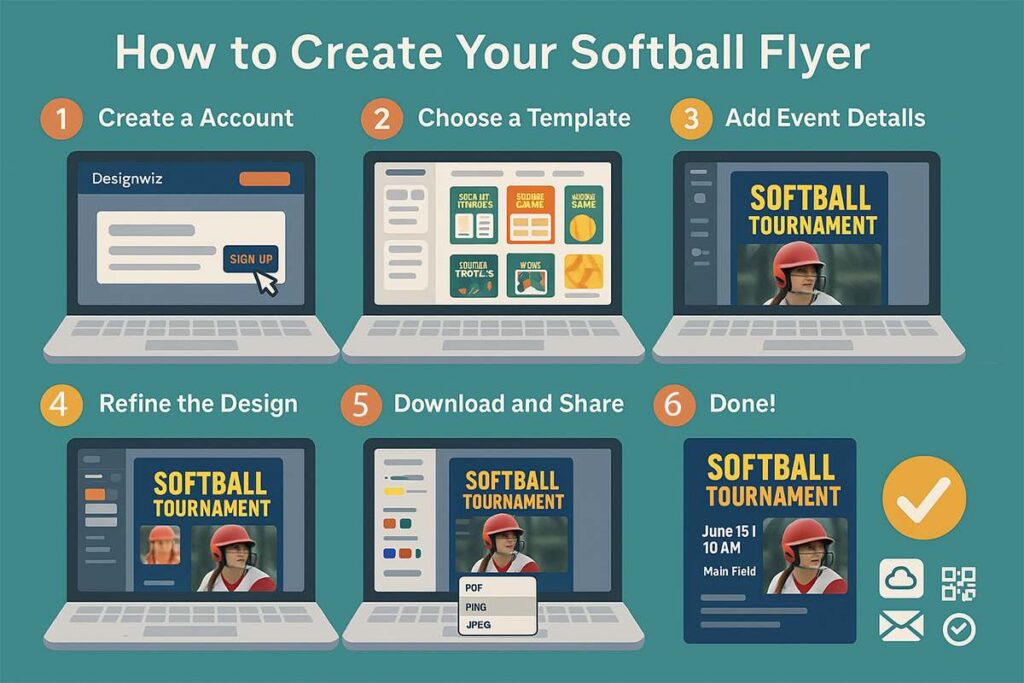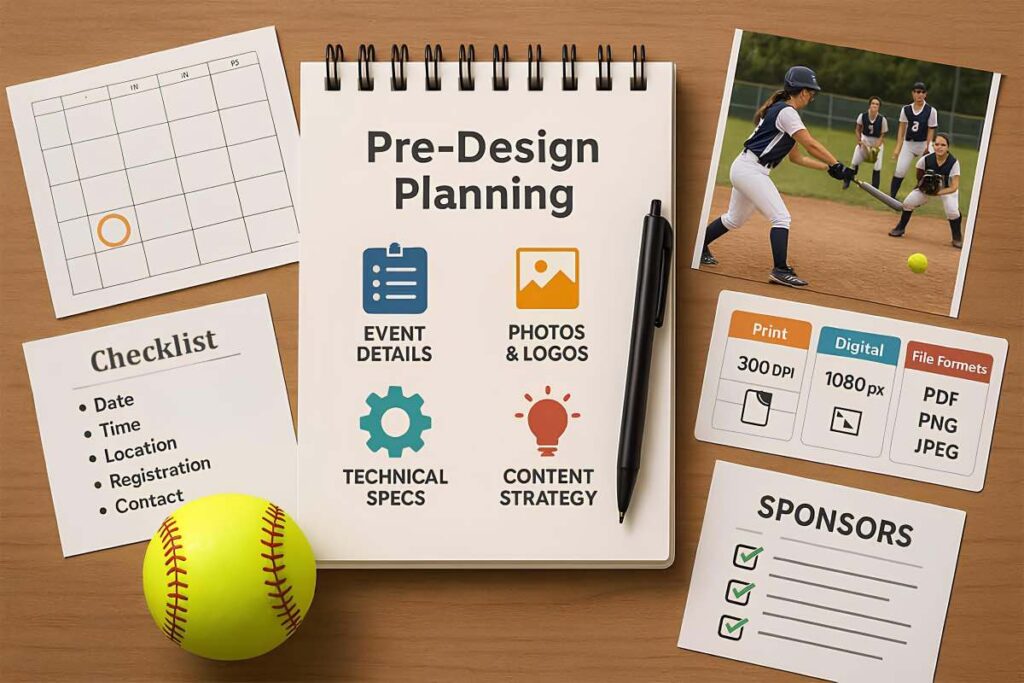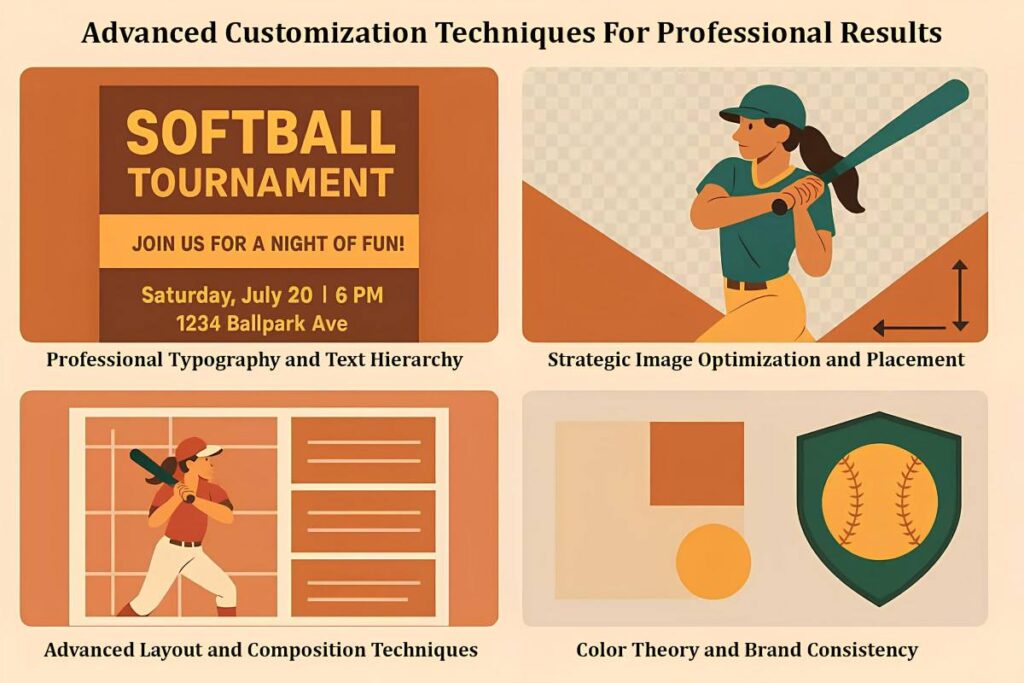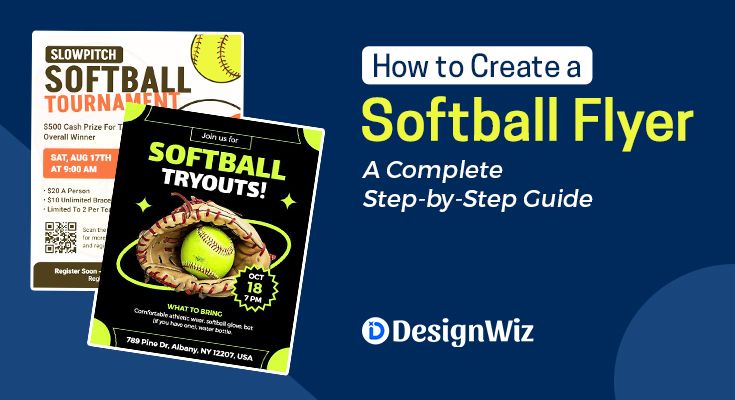Creating a softball flyer involves selecting the right template, organizing key event details, and customizing design elements for both print and digital use. Start by picking a flyer template suited to your event tournament, tryout, camp, or clinic then add essential info like dates, location, and contacts. Use clean fonts, strong visuals, and a clear call-to-action for best results.
This guide simplifies the flyer creation process with a step-by-step approach covering template selection, content organization, and distribution strategies. It’s designed to help you avoid common mistakes like poor design or unclear messaging, and instead create flyers that grab attention and drive participation.
You’ll also get event-specific tips, from tournament flyers with sponsor spots to tryouts focused on player skills, plus strategies for measuring flyer performance and improving future campaigns all while keeping your design professional and cost-effective.
How To Create Your Softball Flyer: Complete Tutorial
Create your softball flyer using DesignWiz by following these steps: create your free account, identify your event purpose, select appropriate templates, customize content with your details, refine the design elements, and download or share your completed flyer. This step-by-step approach ensures you cover all the essentials needed for a polished and effective flyer.
The process involves navigating to designwiz.com, browsing softball-specific templates, adding your event information, uploading photos, adjusting colors and fonts, and exporting in the correct format for your needs. Most users complete their softball flyer in 15-30 minutes using this systematic method while achieving professional results.

Step 1: Create Your DesignWiz Account and Access Templates
Navigate to designwiz.com and click “Sign Up” to create your free account. Complete the email verification process to access your dashboard. The platform offers hundreds of softball-specific templates organized by event type, skill level, and design style. Browse the template library using the search function or category filters to find designs that match your event requirements. The intuitive interface provides drag-and-drop functionality, making customization accessible for users without design experience.
Step 2: Define Your Event Purpose and Choose the Right Template
Start by identifying your event’s primary goal, whether it’s a tournament, tryout, camp, or clinic. Each type demands a different design approach. Understanding your target audience, event timeline, and messaging tone will help you choose a softball flyer that aligns with your objectives.
Once your purpose is clear, select from event-specific template categories:
Softball Tournament Flyers
Multi-team competitive events benefit from templates featuring bracket layouts, team placement areas, and winner recognition sections. These designs emphasize competition structure, prize highlights, and tournament schedule presentation. Tournament templates typically include sponsor recognition areas and registration deadline emphasis.
Here’s a handpicked collection of softball tournament flyers designed to help you promote your event with impact.
- Slow-pitch Softball Tournament Competition Flyer
- Illustrated Softball Tournament Event Flyer
- Athletic Softball Tournament with Iconic Gear Flyer
- Annual Softball Tournament Event Flyer
- Dynamic Red Softball Tournament Sports Event Flyer
Learn More: Softball Tournament Flyer Design: Complete Promotion Guide
Softball Tryout Flyers
Team selection-focused designs highlight player recruitment, skill requirements, and evaluation criteria. These templates feature prominent registration information, application deadlines, and coach contact details. Tryout flyers emphasize opportunity and team building rather than entertainment value.
Browse our collection of softball tryout flyers designed to showcase your tryout details clearly and professionally.
- Dynamic Green 8U Softball Tryouts Registration Flyer
- Softball Team Tryouts Announcement Flyer
- Softball Tryouts Event Information Flyer
- Dynamic Purple Softball Tryouts for Grades 7 and 8 Flyer
- Community Softball Tryouts Announcement Flyer
Learn More: How to Create Softball Tryout Flyer That Attract the Best Players
Softball Camp Flyers
Multi-day training program templates showcase curriculum highlights, age group categorization, and coach credentials. These designs feature educational elements, facility information, and program structure presentation. Camp flyers emphasize skill development and long-term improvement benefits.
These softball camp flyers are perfect for promoting skill development programs. Highlight age groups, coaching staff, and training highlights with customizable designs that are easy to personalize and share.
- Youth Softball Summer Camp Flyer
- Youth Summer Softball Camp Event Flyer
- Summer Softball Camps Registration Flyer
- Softball College Exposure Camp Flyer
- Black and White Fielding Camp Softball Flyer
Learn More: Softball Camp Flyer Design Guide: Attract More Participants This Season
Softball Clinic Flyers
Single-day instructional event templates focus on expert instructors, specialized training, and immediate skill improvement. These designs highlight technique-specific content, quick registration processes, and instructor qualifications. Clinic flyers emphasize targeted learning and immediate results.
These softball clinic flyers are perfect for advertising short-format training events. Customize each flyer to showcase techniques, instructors, and the quick benefits your clinic offers.
- Youth Softball Skills Development Clinics Flyer
- Youth Softball Practice Announcement Flyer
- Youth Softball Training Program Flyer
- Youth Softball Coaching Classes Flyer
- Youth Softball Open Workout Event Flyer
Softball Fundraiser Flyers
Designed for charitable events and donation drives, these templates highlight sponsor recognition, contribution levels, and the impact of community support. Messaging focuses on the cause, encouraging participation by showcasing who benefits and how support helps.
Promote your next fundraiser with ease using these softball fundraiser flyers. Whether you’re organizing a charity game or a donation event, each design can be personalized to reflect your cause and engage your community.
- Athletic Green Softball Tournament Fundraiser Flyer
- Community Softball Fundraiser Event Flyer
- Youth Sports Green Softball Fundraiser Event Flyer
- Dynamic Softball Tournament Fundraiser Event Flyer
- Flaming Softball Community Fundraiser Event Flyer
Learn More: How to Create Softball Fundraiser Flyers That Drive Results
Softball Game Flyers
Ideal for single-match promotions or rivalry games, these designs feature team matchups, player spotlights, and game-day experiences. They promote fan engagement by emphasizing excitement, entertainment, and attendance incentives.
Promote your next softball game with these ready-to-edit flyers. From regular season matchups to big rivalries, each design helps you share key info like time, location, and team rosters with ease.
- Annual Softball Game Event Flyer
- International Softball Game Event Flyer
- Competitive Softball Game Day Flyer
- Verdun Green Softball Game Flyer
- Deep Fir and White Softball Game Flyer
Softball League Flyers
Used for season announcements and ongoing registration, these templates include competition structures, full-season schedules, and team rosters. They highlight division info, long-term commitment, and benefits of participating in a full league.
Planning a new season? These softball league flyers help you promote registration, share league structure, and highlight team details. Customize any design to match your league’s branding and timeline.
- Spring Slowpitch Softball League Flyer
- Patriotic Red and Blue Softball League Announcement Flyer
- Dynamic Orange Summer Softball League Schedule Flyer
- Upcoming Softball League Meeting Flyer
- Pickled Bluewood and Brown Pod Softball League Fundraiser Flyer
Step 3: Customize Your Flyer Content and Information
Add specific event details, including dates, times, locations, and duration. Input registration requirements, deadlines, and contact information clearly. Upload team photos, action shots, and sponsor logos using the built-in image editor. Position visual elements strategically to guide reader attention toward key information. Include necessary disclaimers, age restrictions, and equipment requirements where applicable.
Select appropriate icons from DesignWiz’s comprehensive library to enhance visual communication. Use consistent spacing and alignment tools to maintain professional appearance. Verify all information accuracy before proceeding to design refinement stages.
Step 4: Refine Design Elements for Professional Appearance
Adjust typography using font pairing strategies that enhance readability. Select fonts that maintain legibility at various sizes and viewing distances. Modify color schemes to match team branding while ensuring sufficient contrast for accessibility. The platform provides color palette suggestions and brand consistency tools.
Use drag-and-drop functionality to optimize layout balance and visual hierarchy. Implement design grids and alignment guides for professional positioning. Ensure visual elements support rather than compete with essential information. Test design effectiveness by reviewing at different sizes and formats.
Step 5: Download and Share Your Completed Flyer
Preview your completed design thoroughly, checking for errors, alignment issues, and information accuracy. Select appropriate file formats based on intended use: PDF for printing, PNG for social media, or JPEG for email distribution. Download high-resolution files ensuring print quality meets professional standards.
Access digital sharing options including direct social media posting, email integration, and cloud storage compatibility. Generate QR codes linking to registration pages or additional event information. The platform provides multiple export options supporting various distribution strategies.
Download Options:
- High-resolution PDF for professional printing
- PNG format for social media platforms
- JPEG for email attachments and web use
- Editable format for future modifications
Sharing Features:
- Direct social media integration
- Email marketing compatibility
- Cloud storage synchronization
- Collaborative editing capabilities
This systematic approach ensures consistent results while maintaining design quality and professional appearance. The DesignWiz platform streamlines the creation process, allowing focus on content accuracy and visual impact rather than technical design challenges.
Discover professionally designed softball flyer templates tailored for every type of event tournaments, tryouts, camps, fundraisers, and more. Each template includes a full preview and easy customization options, so you can quickly create eye-catching flyers that match your event goals and branding.
- Women’s Softball World Championship Flyer
- Community Softball Tryouts Announcement Flyer
- Softball Summer Camp Flyer
Read More: Complete Guide to Softball Flyer Design: Expert Tips & Best Practices 2025
The Key Steps Before You Start Designing Softball Flyer: Pre-creation Planning Essentials
Before creating a softball flyer, gather essential event details, including date, time, location, registration requirements, contact information, and event-specific notes. Prepare high-quality team photos, sponsor logos, and any required legal disclaimers. It’s also important to determine your target audience, event goals, and preferred distribution methods to help guide your design choices effectively.
Technical preparation includes understanding file format requirements, print versus digital specifications, and resolution needs. Most successful softball flyers come from thorough planning that involves organizing content, prioritizing key messages, and developing a clear call-to-action strategy—all before starting the actual design process.

Essential Information Gathering
Start by compiling all event details systematically. Create a comprehensive checklist covering:
- Event dates, times, and locations
- Duration and specific requirements
- Registration deadlines and participation fees
- Equipment needs and age restrictions
- Contact information for inquiries
- Emergency contacts and organizational representatives
According to Duke University’s event planning guidelines, systematic information gathering is the “first and most critical step when planning an event,” emphasizing the importance of identifying “what type of event do you want to do,” “what is the purpose of your event,” and “who is the intended audience” before proceeding with promotional materials.1
Collect team photos showcasing action shots, player highlights, and coaching staff. Ensure images are high-resolution (minimum 300 DPI) and properly sized for your intended flyer format. Gather sponsor logos in vector format when possible, maintaining brand guidelines and required sizing specifications.
Record legal requirements including:
- Liability waivers and insurance information
- Safety protocols and weather contingency plans
- Facility backup options for outdoor events
- Special accommodations for participants with disabilities
- Dietary requirement considerations
Technical Requirements and Specifications Setup
Determine your primary distribution method before selecting technical specifications. Print flyers require 300 DPI resolution with CMYK color profiles. Digital distribution uses RGB colors with optimized file sizes for email and social media sharing.
Select appropriate dimensions based on distribution needs. Standard 8.5×11 inches works for most print applications. 11×17 inches provides enhanced visibility for bulletin boards and facility posting. Digital formats should consider platform-specific requirements:
- Instagram posts: 1080×1080 pixels
- Facebook events: 1920×1080 pixels
- Email newsletters: 600-800 pixels wide
Choose file formats strategically. PDF maintains quality across devices and printing systems. PNG provides transparency options for digital overlays. JPEG offers smaller file sizes for email distribution. Plan for multiple format outputs to maximize distribution flexibility.
Content Strategy and Message Development
Establish clear information hierarchy prioritizing essential details. Primary information includes event name, date, time, and location. Secondary details cover registration procedures, costs, and contact information. Supporting elements feature team highlights, sponsor recognition, and additional event activities.
Develop compelling headlines that capture attention while conveying key information. Use action-oriented language that encourages participation: “Join Our Championship Tournament” rather than “Softball Tournament Available.” Create urgency through limited-time offers, early registration discounts, or capacity restrictions.
Plan your call-to-action strategy carefully. Include specific steps for registration, clear deadlines, and multiple contact options. Position CTAs prominently using contrasting colors and readable fonts. Test contact methods before finalizing to ensure functionality across all platforms.
The University of Oregon recommends using concise, prioritized information such as event title, date, location, and a bulleted benefit list (15-20 words max) paired with strong headlines and prominent calls to action in contrasting fonts, ensuring readability and engagement within 12 seconds on digital displays.2
Address target audience considerations through appropriate tone and messaging:
- Youth leagues: Parent-focused information emphasizing safety and skill development
- Adult recreational leagues: Social aspects and competitive balance highlights
- Tournament announcements: Prize information and competitive achievement recognition
Visual Organization and Design Planning
Create a visual layout strategy before beginning design work. Plan image placement, text blocks, and white space distribution. Consider reading patterns with important information in upper-left positions for maximum visibility.
Select color schemes that enhance readability while reflecting team identity. Avoid overwhelming backgrounds that compete with text legibility. Plan consistent spacing between elements and maintain adequate margins for print specifications.
Organize content blocks logically with clear section divisions. Group related information together and use consistent formatting throughout. Plan for scalability across different sizes while maintaining readability and visual impact.
Pre-Design Quality Control
Review all gathered information for accuracy and completeness. Verify event details, contact information, and sponsor requirements. Confirm image quality and legal compliance before proceeding with design work.
Create backup plans for potential changes or updates. Organize files systematically for easy access during the design process. Establish approval workflows with stakeholders to streamline revision processes.
This systematic pre-creation approach ensures your softball flyer design process proceeds smoothly with all necessary elements organized and ready for professional implementation.
Learn More: How to Attract Crowd at Your Softball Event with Stunning Flyers
Advanced Customization Techniques For Professional Results
Advanced softball flyer customization involves sophisticated text formatting, professional image optimization, strategic layout composition, and consistent branding. Use font pairing strategies to establish visual hierarchy, optimize images for both quality and placement, apply design grids for precise alignment, and ensure a uniform color scheme throughout the flyer.
Additional techniques include background removal, transparency effects, custom spacing, and advanced typography selections that improve readability while enhancing visual appeal. The most professional results come from meticulous attention to alignment, spacing, color harmony, and overall design balance resulting in polished and engaging softball marketing materials.

Professional Typography and Text Hierarchy
Typography creates the foundation for professional softball flyers. Select primary fonts that reflect your team’s personality while maintaining readability across all viewing distances. Pair bold display fonts for headlines with clean sans-serif fonts for body text. Create visual hierarchy through font size variations: use 36-48pt for main headlines, 24-28pt for subheadings, and 12-16pt for body text and contact information.
Advanced text formatting includes letter spacing adjustments for improved readability, line height optimization for comfortable reading, and strategic use of text effects like drop shadows or outlines for visibility over complex backgrounds. Avoid overusing text effects subtle enhancements work better than dramatic styling that can appear unprofessional.
According to the Interaction Design Foundation, using 3:1 size ratios for headers compared to body text, pairing bold display fonts with clean sans-serifs, and applying clear spacing and contrast are essential for establishing visual hierarchy helping key information stand out and improving readability at a glance.3
Strategic Image Optimization and Placement
High-quality images elevate softball flyer design from amateur to professional. Upload images at 300 DPI minimum resolution to ensure crisp printing quality. Use the crop tool to eliminate distracting background elements and focus attention on key subjects like players in action or team celebrations.
Background removal techniques create clean compositions that integrate seamlessly with your design. Remove complex backgrounds from player photos to create transparent cutouts that can be positioned over colored backgrounds or gradient overlays. This technique allows for more flexible layouts and professional presentation.
Image positioning follows the rule of thirds for visual balance. Place key visual elements at intersection points rather than dead center. Layer multiple images using transparency effects to create depth and visual interest without overwhelming the design.
Advanced Layout and Composition Techniques
Professional layouts utilize invisible grids that organize content systematically. DesignWiz provides alignment guides that snap elements to consistent positions, creating visual harmony. Use these guides to align text blocks, images, and design elements to invisible grid lines.
White space management separates amateur from professional design. Allow adequate breathing room around text and images cramped layouts appear unprofessional and reduce readability. Create visual groupings by spacing related elements closer together while adding more distance between unrelated sections.
Balance asymmetrical layouts by distributing visual weight evenly. If you place a large image on one side, balance it with text blocks or multiple smaller elements on the opposite side. This creates dynamic composition while maintaining visual stability.
Color Theory and Brand Consistency
Advanced color application goes beyond team colors to create sophisticated palettes that enhance readability and visual appeal. Use the 60-30-10 rule: 60% dominant color (usually neutral), 30% secondary color (team primary), and 10% accent color (team secondary or complementary).
Color temperature affects mood and perception. Warm colors (reds, oranges, yellows) create energy and excitement, perfect for tournament announcements. Cool colors (blues, greens, purples) suggest professionalism and trust, ideal for league information or coaching credentials.
Contrast ratios ensure accessibility and readability. Test text color against background colors to maintain sufficient contrast for easy reading. Dark text on light backgrounds typically provides better readability than reversed combinations.
According to the University of Michigan, accessible color usage requires maintaining sufficient contrast (at least 4.5:1 for body text, 3:1 for large text), and not relying solely on color to convey meaning a crucial principle for softball flyers to ensure readability and brand cohesion across all viewing scenarios.4
Advanced Design Elements and Effects
Professional softball flyers incorporate subtle design elements that add sophistication without distraction. Use gradient overlays on background images to ensure text readability while maintaining visual interest. Apply these gradually from transparent to semi-opaque rather than harsh color blocks.
Border and frame effects can enhance professionalism when used sparingly. Thin borders around images or text blocks create definition without overwhelming the design. Avoid heavy decorative borders that can appear dated.
Quality Control and Technical Excellence
Professional results require systematic quality control processes. Review designs at 100% zoom to check text clarity, image sharpness, and alignment precision. Test printing at actual size to identify potential issues before final production.
Color profile management ensures consistency across different devices and printing methods. Use CMYK color profiles for print materials and RGB for digital distribution. This prevents color shifts that can compromise your professional appearance.
File organization supports professional workflows. Name layers descriptively, group related elements, and maintain consistent naming conventions for easy editing and updates.
Browse a wide range of professionally designed softball flyer templates on DesignWiz. This tool offers event-specific layouts with flexible customization, helping you create professional flyers without starting from scratch.
- Patriotic Red and Blue Softball League Announcement Flyer
- Dynamic Softball Tournament Fundraiser Event Flyer
- Mens Softball Upcoming Game Flyer
How To Optimize Your Softball Flyer For Different Distribution Methods
Optimizing softball flyers for different distribution methods requires format-specific customization, technical specifications, and strategic placement considerations. For print distribution, use high-resolution files (300 DPI), durable paper stock, and weather-resistant materials if the flyers will be posted outdoors. Digital distribution demands various file formats, platform-specific sizing, and optimized file sizes suitable for email campaigns and social media sharing.
Physical distribution also involves strategic placement, proper timing, visibility considerations, and the use of trackable features like QR codes. The most effective campaigns typically use a multi-channel approach with format-optimized versions to ensure consistent messaging across print, digital, and social platforms while maintaining a professional appearance and achieving maximum engagement rates.

Print Distribution Optimization
Print distribution demands high-resolution files at 300 DPI minimum for professional results. Standard paper stock works for indoor posting, but outdoor locations require 80-100lb glossy stock with weather-resistant coating. Common sizes include 8.5×11 inches for bulletin boards and 11×17 inches for maximum visibility at sports facilities.
Plan bulk printing during off-season months for 20-30% cost savings. Consider lamination for tournament flyers posted outdoors, extending lifespan from days to weeks. Include bleed areas extending 0.125 inches beyond trim lines to prevent white edges during cutting.
Digital Distribution Specifications
Digital formats require multiple file versions optimized for specific platforms. Create PDF files for email attachments, maintaining vector graphics for crisp text at any size. Export PNG files for social media posts, using RGB color profiles for optimal screen display.
Compress images to 1-2MB maximum for email compatibility while maintaining visual quality. Test across devices – tablets, smartphones, and desktop computers – ensuring text remains readable at various screen sizes. Include clickable elements directing users to registration pages or team websites.
Social Media Platform Optimization
Each platform demands specific dimensions and formatting. Instagram requires 1080×1080 pixels for feed posts and 1080×1920 pixels for Stories. Facebook covers need 1200×630 pixels for optimal display across devices. LinkedIn company pages perform best with 1192×628 pixel images.
Create platform-specific hashtag strategies: #SoftballTryouts, #YouthSoftball, #LocalSports for broader reach. Include team handles and location tags to increase local visibility. Consider carousel posts showcasing multiple flyer designs or highlighting different event details.
Email Marketing Integration
Email distribution requires careful file size management and mobile optimization. Embed images directly in email body rather than attachments to improve open rates. Use compelling subject lines incorporating event details: “Softball Tryouts This Saturday – Register Now!”
Test email appearance across major clients – Gmail, Outlook, Apple Mail – ensuring consistent formatting. Include plain text versions for accessibility compliance. Add clear call-to-action buttons linking to registration forms or team contact information.
Physical Posting and Community Distribution
Strategic location selection maximizes visibility among target audiences. Sports facilities, community centers, and youth organizations offer prime posting opportunities. Secure necessary permissions before posting to avoid removal.
Time posting for maximum foot traffic – typically mornings and after-school hours for youth-focused events. Use eye-catching colors and bold fonts visible from 10 feet away. Position flyers at eye level (5-6 feet) for optimal readability.
Partner with local businesses for cross-promotional opportunities. Many sports equipment stores, restaurants, and community centers welcome well-designed promotional materials that serve their customers.
QR Code Integration for Multi-Channel Tracking
QR codes bridge print and digital distribution methods effectively. Generate codes linking to registration pages, team websites, or event information. Position codes prominently but maintain design balance – typically bottom-right corner works best.
Use dynamic QR codes allowing information updates without reprinting materials. Track scan analytics to measure engagement rates and optimize future campaigns. Include brief instructions: “Scan for instant registration” to encourage usage.
Test QR code functionality across multiple devices before printing. Ensure destination pages load quickly and display properly on smartphones. Consider backup options like short URLs for users without QR scanning capability.
Performance Tracking Across Distribution Methods
Monitor effectiveness metrics for each distribution channel. Track registration sources, website traffic spikes, and social media engagement to identify highest-performing methods. Email campaigns provide detailed analytics including open rates, click-through rates, and conversion tracking.
Physical distribution requires creative tracking methods. Use unique phone numbers or promotional codes for different locations. Survey new participants about how they discovered the event to refine future distribution strategies.
Successful softball flyer distribution combines multiple channels with format-optimized versions, ensuring maximum reach while maintaining professional appearance and clear messaging across all platforms.
People Also Ask About Softball Flyer Creation
What size should a softball flyer be?
Standard softball flyers work best at 8.5×11 inches for easy printing and posting. For tournaments, consider 11×17 inches for more impact. Digital flyers should be 1080×1080 pixels for social media or 1200×628 pixels for Facebook events.
What information must be included on a softball flyer?
Essential information includes event date, time, location, registration deadline, contact details, and clear call-to-action. Add team logos, coach credentials for clinics, skill requirements for tryouts, and sponsor acknowledgments for tournaments to maximize effectiveness.
How do I make my softball flyer stand out?
Use bold action photos, vibrant team colors, and clear typography hierarchy. Include unique selling points like ‘championship coaches’ or ‘skill development guarantee.’ Avoid cluttered designs and ensure key information is readable from 3 feet away.
What fonts work best for softball flyers?
Use bold, readable fonts like Arial Black, Impact, or Bebas Neue for headers. For body text, stick to Arial, Helvetica, or Calibri. Avoid decorative fonts that reduce readability. Maintain consistent font pairing throughout the design.
How do I add team photos to my softball flyer?
Use high-resolution action shots (minimum 300 DPI) showing players in uniform. Position photos strategically without covering important text. In DesignWiz, upload images through the media library and use cropping tools for optimal placement and sizing.
What colors work best for softball flyers?
Use your team’s official colors as primary choices, with high contrast combinations for readability. Popular softball color schemes include navy/gold, red/white, or green/silver. Ensure text remains legible against background colors in both print and digital formats.
FAQs About About Softball Flyer Creation
Match template style to the event: use tournament layouts for competitions, tryout designs for skills, camp templates for learning, and game templates for single matches. Choose colors and images based on age group and competition level.
Print flyers need 300 DPI, CMYK color, and PDF with bleed. Digital flyers use 72 DPI, RGB, and PNG/JPEG. Print needs larger text (12pt+), while digital allows smaller fonts due to zoom.
Use high contrast color combinations (dark text on light backgrounds), minimum 12pt font size for body text, and 18pt+ for headers. Test readability by printing at actual size and viewing from 3 feet away. Avoid placing text over busy background images.
Distribute tryout flyers 4–6 weeks ahead, tournament flyers 6–8 weeks before, and camp flyers 2–3 months in advance. Post at sports venues during peak times like evenings and weekends.
Include format, divisions, prizes, and registration deadlines. Use action shots, bold branding, and clear brackets. Highlight venue, competition level, and special awards to boost participation.
Print flyers need 300 DPI, CMYK, and PDF with bleed; digital flyers use 72 DPI, RGB, and PNG/JPEG formats. Print requires larger text (12pt+), while digital can use smaller fonts due to zooming.
Highlight skill-building programs, expert coaches, and a clear daily schedule. Include age-specific activities, facility highlights, and key learning outcomes. Use educational visuals and testimonials to build parent and player trust.
Conclusion
Creating effective softball flyers takes thoughtful planning, structured execution, and smart distribution. Teams that follow a consistent design process often experience better turnout and engagement than those that create flyers on the fly. A well-planned approach can make a big difference in how many people show up and take interest.
This flyer creation guide equips you with a complete framework from pre-design planning and template selection to professional customization and multi-channel distribution. DesignWiz simplifies the entire process, helping you turn basic templates into powerful marketing assets.
By applying consistent branding, quality visuals, and performance tracking, you’ll increase team recognition, improve conversions, and maximize event turnout.
Reference
- “Event Planning Guide.” Duke University School of Law (2025).
- “Event Promotion Guidelines.” University of Oregon – College of Design.
- “What is Visual Hierarchy?” Interaction Design Foundation (2025).
- “Color & Contrast Principles.” University of Michigan Accessibility.



